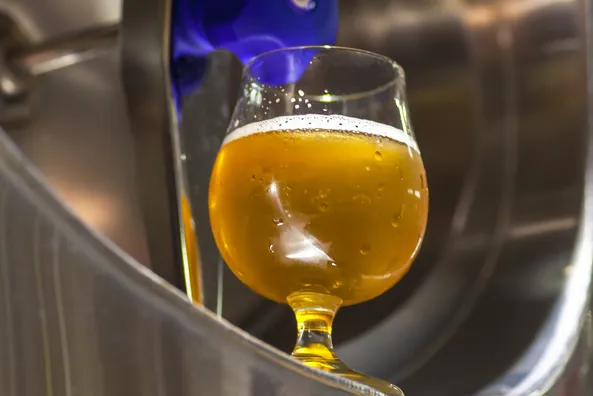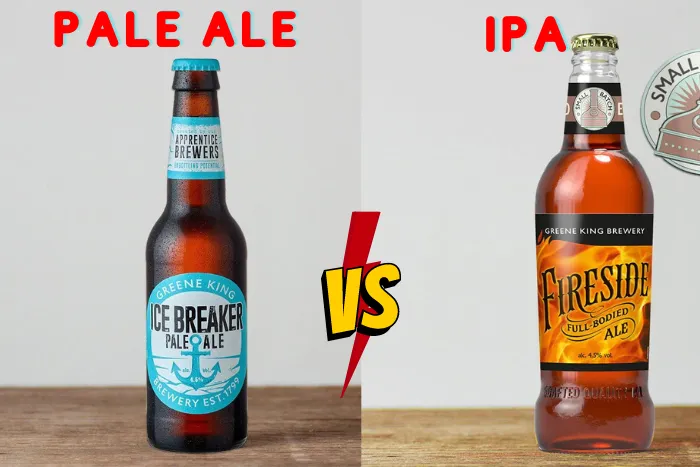The debate between a pale ale and ale has been around for centuries. But what exactly is the difference? Is one beer better than the other, or do they have their unique qualities? In this blog post, we will explore the history of both types of beers, compare the brewing processes and ingredients of pale ales vs. ales, discuss taste, color, alcohol content, and calorie comparison between them, and provide some famous examples from all over the world. We’ll also highlight some potential benefits of drinking different types of beer, like pale ales and ales. So read on to learn why it’s worth trying a variety!
Table of Contents:
- History of Pale Ale and Ale
- Brewing Process for Pale Ale and Ale
- Taste, Color, Alcohol Content, and Calorie Content Comparison Between Pale Ale and Ale Beers
- Popular Examples of Pale Ales and Ales Around the World
- FAQs in Relation to Pale Ale vs Ale
- Conclusion
Origin of Pale Ale:
Pale ale is a beer that originated in England during the 1700s. It was first brewed using pale malt, kilned at a higher temperature than other malts used to make dark beers.
It gave the beer its distinctive light color and crisp flavor. The popularity of pale ales multiplied throughout Europe and eventually made its way to America, becoming one of the most popular beer styles.
Origin of Ale:
Ales are an ancient style of beer that has been around for centuries. They were initially brewed with top-fermenting yeast strains, which give them their unique flavor profile compared to lagers or pilsners.
Ales come in various varieties, such as stouts, IPAs, brown ales, wheat beers, and more.
Pale Ale and Ale have been brewed for centuries, each with its unique flavor profile. In the next section, we’ll look at the brewing process for both types of beer to explore how their distinctive flavors are created.
Brewing Process for Pale Ale and Ale

Pale Ale and Ale are two of the most popular types of beer around the world. They have different origins, brewing processes, tastes, colors, alcohol content, and calorie content.
To understand how these beers are brewed and compare them in terms of their characteristics, it is essential to look at the ingredients used in each type of beer and the steps involved in producing them.
Ingredients Used in Pale Ale Brewing
Malted barley is the main ingredient used for pale ale brewing, which provides a light color and sweet flavor. Other grains, such as wheat or oats, can also be added to give more complexity to the flavor profile.
Hops are also essential to this beer style; they provide bitterness and aroma that help balance the sweetness from malt sugars. Yeast is then added to ferment all these ingredients into a delicious beverage.
Ingredients Used in Ale Brewing
Malted barley is still used for ales but with a higher proportion than what’s found in pale ales – giving it a darker color and fuller body compared to its lighter counterpart. Hops are also included, but usually not as much since there’s already enough bitterness from malt sugars during fermentation.
Other grains like wheat or oats may be added for additional flavors too. Lastly, yeast will be again needed for fermentation so that all these ingredients come together in one tasty brew.
Brewing both pale ale and ale beers requires the same basic process. However, slight differences in ingredients will produce two distinct types of beer. Now let’s take a look at how the taste, color, alcohol content, and calorie content differ between these two popular styles of beer.
Taste, Color, Alcohol Content, and Calorie Content Comparison Between Pale Ale and Ale Beers
Taste Differences Between Pale Ales and Ales
The taste of a beer is primarily determined by the type of malt used in its production. Pale ales are typically made with pale malts, which give them a lighter flavor profile than other beers. They often have notes of citrus or floral hops and a slight sweetness from the malt.
On the other hand, ales tend to be more malty and sweet due to their use of darker malts such as caramel or chocolate malts. These beers also usually have higher hop bitterness levels than pale ales.
Color Differences Between Pale Ales and Ales
The color difference between pale and ales can be noticeable depending on the malt used during brewing. Generally speaking, pale ales range from light golden hues to amber-orange colors, while most ales range from deep copper tones to dark browns or black shades.
Alcohol Content Differences Between Pale Ales and Ales
The alcohol content is another factor that distinguishes these two types of beer styles from one another; generally speaking, pale ale alcohol contents range between 4% – 6%, whereas most ale alcohol contents fall somewhere between 5% – 8%.
Calorie Content Differences Between Pale Ales and Ales
There is slight variation regarding calorie content differences between these two types of beer styles; pale ale beers and ale beers contain roughly 150 calories per 12 oz serving size regardless of whether they are light or regular versions.
When comparing pale ales and ales, it is essential to consider the taste, color, alcohol content, and calorie content of each beer. Now, look at some famous examples of pale ales and ales worldwide.
Popular Examples of American-Style Pale Ales Around the World:
One famous example of an American-style pale ale is Sierra Nevada’s, Pale Ale. This beer has a light golden color and a hoppy, citrusy flavor with hints of pine and caramel. It has an ABV (alcohol by volume) of 5.6% and is one of America’s most widely available craft beers.
Another famous example is Founders Brewing Co.’s All Day IPA which features a light amber color with notes of tropical fruit, floral hops, and toasted malt flavors. This beer also has an ABV of 4.7%.
Popular Examples of English-Style Pales Around the World:
A classic example from England would be Fuller’s London Pride which offers a smooth malty taste with hints of biscuit, nuts, and caramelized sugar balanced out by earthy hop bitterness for balance. It also has an ABV content of 4.7%.
Other examples include Greene King IPA or Adnams Broadside, both dark copper-colored ales that offer sweet maltiness, fruity esters like apple or pear on the nose, and some spicy hop character in the finish for balance. Both have ABVs around 5%.
Popular Examples Of American-Style IPAs Around The World:
American IPAs tend to be more heavily hopped than their English counterparts, so they often have higher levels of alcohol content and intense aromas and flavors such as grapefruit, pineapple, mango, and citrus zest.
Famous examples include Stone Brewing’s Enjoy By IPA, which packs plenty of hop aroma but remains drinkable due to its low bitterness level; it clocks in at 9% ABV.
Dogfish Head 90 Minute Imperial IPA is another excellent choice offering up bold notes of pine resin alongside sweet malts, all while maintaining good drinkability despite its high 8%-9% ABV range.
FAQs in Relation to Pale Ale vs Ale
Is an IPA a pale ale?
An IPA (India Pale Ale) is not a pale ale. An IPA is a type of beer that has higher hop bitterness and alcohol content than most other styles of beer. It also typically has more intense aromas and flavors due to the increased hops in its production. On the other hand, pale ales are generally less bitter, with lower alcohol content and fewer hop aromas or flavors.
What makes a pale ale a pale ale?
A pale ale is a type of beer with a light to medium body, low hop bitterness and flavor, and an amber to copper color. It typically uses pale malts as the primary grain in its recipe, which gives it its characteristic golden hue. Pale ales ferment at higher temperatures than lagers and stouts, producing fruitier esters. Due to their balanced flavour profile and moderate alcohol content (4-6%), they pair well with many foods.
Is pale ale the same as light ale?
No, pale ale and light ale are not the same. Pale ales are more full-bodied and have a higher hop content than light ales. They also typically have a higher alcohol content than light ales. Light ales are usually lower in alcohol content, lighter in the body, and less hoppy than pale ales. Both styles of beer have different flavour profiles and ABVs, depending on the brewery that makes them (alcohol by volume).
Conclusion
In conclusion, pale ale and ale beers are two of the most popular beer styles in the world. They have different histories, brewing processes, ingredients, tastes, colors, alcohol contents, and calorie counts. Famous examples of pale ales and ales worldwide include India Pale Ale (IPA), American Pale Ale (APA), and Belgian Ales. Ultimately it is up to you to decide which type of beer suits your taste best – whether it be a pale ale or an ale!
Are you a beer enthusiast looking for the best pale ale or ale? Look no further! Our blog will provide all of your needs. We’ll review different beers, advise on what type is right for you, and offer helpful tips on how to make it yourself.
We have everything covered, from subscription services that deliver fresh craft brews to your door to detailed instructions on setting up home brewing equipment! Check out our blog today, and let us help you discover the perfect pint!

